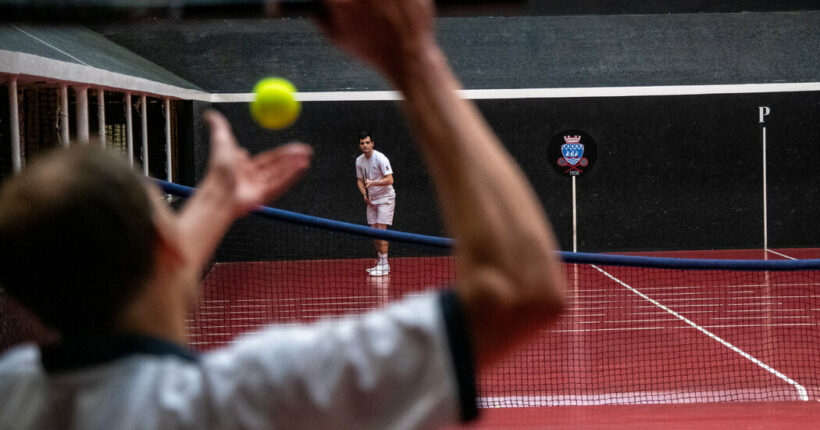Up on the second floor, hidden behind the facade of a tall Haussmann building not far from the Arc de Triomphe, is the Jeu de Paume Club, the only active court tennis club in Paris.
The members of the club, like the players at Wimbledon in England, are dressed all in white, and they call out the scores “quinze!” and “trente!” just the same as the umpires a few miles west, at Roland Garros, where the French Open is being played through June 11.
Modern tennis, or lawn tennis, which was formally invented in England in the 1870s, bears many of the traces of court tennis, not least the basic vocabulary of scoring, even if no one has definitively proven if it is referenced from medieval horological sources or the paces that a player advanced when he won a point in the game of longue paume, the ancestor of most racket sports but particularly lawn tennis, which has been played in villages across France since the 13th century.
Court tennis, also known as real tennis, developed 200 years later, according to Gil Kressmann, a historian and the honorary president of the Jeu de Paume Club, as cities evolved in France and walled courts replaced the large open spaces previously used for longue paume. The sport took off across Europe and Britain, where it was championed by Henry VIII.
The courts in France then, as today, were managed by professionals known as maîtres paumiers, who performed in matches, gave lessons and made the balls and rackets. As for the last requirement, Guillaume Dortu, the current club professional at the Palace of Fontainebleau, did not hide his relief that “mercifully, professionals don’t have to do that today.”
But he and other club pros like Rod McNaughtan in Paris are the only people allowed to sell court tennis rackets, which are still constructed of wood. Each month, they make 100 to 150 balls, carefully weighing the hard core of cork and cotton webbing before stitching the thick yellow felt exterior by hand. They also clean the court daily.
Enthusiasm for the game started to wane at the end the 17th century, and it was linked to gambling and less salubrious events such as when the Italian painter Michelangelo Merisi, better known as Caravaggio, killed an opponent on a tennis court in Rome in 1606, leading to his being banished from the city. In France, the game’s popularity suffered under Louis XIV, whose heavy physique discouraged him from playing. He was keener on billiards.
The French Revolution, which began in 1789, distracted from the game, though one of the revolution’s founding moments, the Tennis Court Oath, took place in the tennis court at Versailles, where deputies convened after being locked out of the palace, swearing not to disband until France had a constitution.
Today, the sport is played competitively in the four countries that also make up tennis’s Grand Slam: France, where the game is known as jeu de paume; Britain and Australia, where it goes by real tennis; and the United States, home of the current men’s world champion, Camden Riviere. There are just over 50 courts in the world, and the prohibitive cost of constructing new courts is a major issue. While the game is gaining in popularity, there are only around 10,000 active players.
Whatever they might lack in numbers, court tennis players make up for with enthusiasm. When asked to describe the sport, they most frequently compare it to chess and say its cerebral demands are as important, if not more so, than the physical ones.
Players take pride in the esoteric nature of the game as well as its asymmetrical court with buttress, galleries, numerous nooks and crannies with odd names and the fact that no two courts in the world are exactly the same. Therein lies the challenge for players like Matthieu Sarlangue, who is ranked No. 10 in the world and is a 13-time French amateur champion. “Technically it’s very difficult and demanding,” he said. “You really have to master the tactics because there are so many options on the court.”
The game is a sporting conundrum, one that Martin Village, a 70-year-old court tennis enthusiast from London and member of the Dedanists’ Society, a small group of British players dedicated to the history of the sport, explained simply.
“If you wanted to design a game that was going to put people off from playing it,” he said, “you would probably design a real tennis court. But that’s why it is a source of endless fascination.”
Source: Read Full Article





